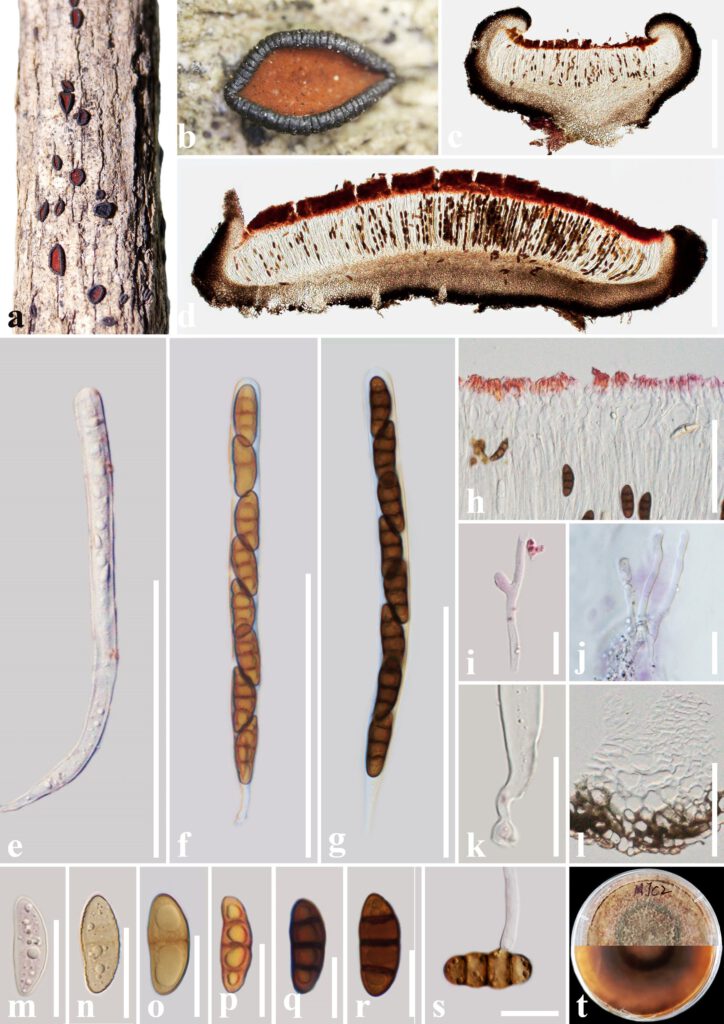Rhytidhysteron coffeae T.Y. Du and Tibpromma sp. nov. (Figure 2)
MycoBank number: MB; Index Fungorum number: IF; Facesoffungi number: FoF 12958;
Etymology: Named after the host name, Coffea sp.
Holotype: HKAS 122700
Saprobic on decaying wood of Coffea sp. (Rubiaceae). Sexual morph: Ascomata 1000–1700 μm long × 1000–1200 μm wide × 300–600 μm high (x̅ = 1520 × 1120 × 450 μm, n = 5), hysterothecial, solitary to aggregated, mostly solitary, superficial, base is embedded in the plant tissue, navicular, black, apothecioid, rough, perpendicularly striate, elongate and depressed, compressed at apex, and open a nearly circular opening through a longitudinal slit, reddish-brown at the center. Exciple 70–160 μm wide (x̅= 95 μm, n = 10), composed of dark brown, thick-walled cells of textura angularis, outer layer brown to dark brown, inner layer pale brown to hyaline. Hamathecium comprising 2–3 μm wide, dense, hyaline, septate, branched, cellular pseudoparaphyses, forming a red to purple epithecium above asci when mounted in water, becoming dark purple epithecium above the asci when mounted in 10% KOH and turns hyaline after 5 seconds. Asci (162–)170–197 μm × (9–)10–14(–16) μm (x̅= 179.5 × 13 μm, n = 20), 8-spored, bitunicate, cylindrical, with short pedicel, rounded at the apex, with an ocular chamber, J–. Ascospores 23–28.5 μm × 8.5–11.5 μm (x̅= 26 × 10 μm, n = 30), uni-seriate, slightly overlapping, hyaline when immature, becoming reddish-brown to brown when mature, ellipsoidal to fusoid, straight or curved, rounded to slightly pointed at both ends, 3-septate, guttulate, smooth-walled, without the mucilaginous sheath. Asexual morph: Undetermined.
Culture characteristics: Ascospores germinating on PDA within 24 h and germ tubes produced from one or both ends. Colonies on PDA reached a 6 cm diameter after two weeks at 28°C. The colony flossy, velvety, circular, slightly raised, with an entire edge, reddish-brown on the forward and in reverse, a green circle in the middle.
Material examined: China, Yunnan Province, Pu’er City, Mojiang County, Jinggong coffee plantation, decaying wood of Coffea sp. L. (Rubiaceae), 23 December 2020, L. Lu, MJC2 (holotype, HKAS 122700, ex-type living culture, KUMCC 21-0489), Yunnan Province, Pu’er City, Qixiang coffee plantation, on decaying wood of Coffea sp. (Rubiaceae), 25 December 2020, L. Lu, QXC8 (HKAS 122701, living culture, KUMCC 21-0492).
Notes: Rhytidhysteron coffeae was closely related to Rhytidhysteron mangrovei Vinit & K.D. Hyde and formed a well-supported clade (99% ML/1.00 PP). However, R. coffeae is distinct from R. mangrovei in having branched pseudoparaphyses, asci 8-spored, and ascospores 3-septate, while R. mangrovei has unbranched pseudoparaphyses, asci (2–6–)8-spored, and ascospores (1–)3-septate (Kumar et al. 2019). In addition, the ascomata, asci and ascospores size of R. coffeae are larger than those of R. mangrovei (ascomata:1520 × 1120 × 450 μm vs 940 × 800 × 500 μm, asci: 179.5 × 13 μm vs 146 × 9.5 μm, ascospores: 26 × 10 μm vs 23 × 8.3 μm) (Kumar et al. 2019). Moreover, according to the comparison results of different gene fragments, R. coffeae is different from R. mangrovei in ITS (77/651 bp, 11.83%) and TEF (21/960, 2.19%) genes (≥1.5%). Therefore, in this study, R. coffeae is introduced as a new species.

Figure 2. Rhytidhysteron coffeae (HKAS 122701, holotype). a, b Appearance of hysterothecia on the host. c, d Vertical section through hysterothecium. e-g Asci. h Epithecium mounted in water. i, j Pseudoparaphyses. k Pedicel of asci. l Exciple. m-r Ascospores. s A germinating ascospore. t Colony on PDA medium (after four weeks). Scale bars: c, d = 500 μm, e-g = 100 μm, h, l = 50 μm, i-k, m-s = 20 μm.
